
The Uffizi Gallery is a prominent art museum located adjacent to the Piazza della Signoria in the Historic Centre of Florence in the region of Tuscany, Italy. One of the most important Italian museums and the most visited, it is also one of the largest and best-known in the world and holds a collection of priceless works, particularly from the period of the Italian Renaissance.
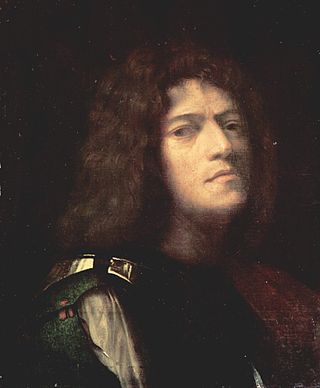
Giorgione was an Italian painter of the Venetian school during the High Renaissance, who died in his thirties. He is known for the elusive poetic quality of his work, though only about six surviving paintings are firmly attributed to him. The uncertainty surrounding the identity and meaning of his work has made Giorgione one of the most mysterious figures in European art.

Tiziano Vecelli or Vecellio ,, Latinized as Titianus, hence known in English as Titian, was an Italian (Venetian) Renaissance painter of Lombard origin, considered the most important member of the 16th-century Venetian school. He was born in Pieve di Cadore, near Belluno. During his lifetime he was often called da Cadore, 'from Cadore', taken from his native region.

The Palazzo Pitti, in English sometimes called the Pitti Palace, is a vast, mainly Renaissance, palace in Florence, Italy. It is situated on the south side of the River Arno, a short distance from the Ponte Vecchio. The core of the present palazzo dates from 1458 and was originally the town residence of Luca Pitti, an ambitious Florentine banker.

Paris Bordone was an Italian painter of the Venetian Renaissance who, despite training with Titian, maintained a strand of Mannerist complexity and provincial vigor.
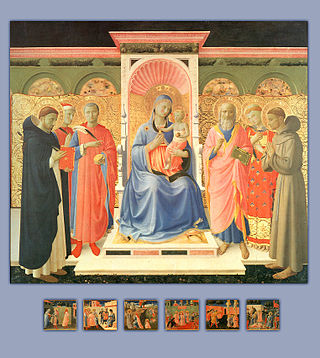
In art, a sacra conversazione, meaning "holy conversation", is a genre developed in Italian Renaissance painting, with a depiction of the Virgin and Child amidst a group of saints in a relatively informal grouping, as opposed to the more rigid and hierarchical compositions of earlier periods. Donor portraits may also be included, generally kneeling, often their patron saint is presenting them to the Virgin, and angels are frequently in attendance.

The Madonna del cardellino or Madonna of the Goldfinch is an oil on wood painting by the Italian Renaissance artist Raphael, from c. 1505–1506. A 10-year restoration process was completed in 2008, after which the painting was returned to its home at the Uffizi in Florence. During the restoration, an antique copy replaced the painting in the gallery.

The Pesaro Madonna is a painting by the late Italian Renaissance master Titian, commissioned by Jacopo Pesaro, whose family acquired in 1518 the chapel in the Frari Basilica in Venice for which the work was painted, and where it remains today. Jacopo was Bishop of Paphos, in Cyprus, and had been named commander of the papal fleet by the Borgia pope, Alexander VI. This painting recalls one of Titian's earliest paintings Jacopo Pesaro being presented by Pope Alexander VI to Saint Peter, c. 1510-11

Italian Renaissance painting is the painting of the period beginning in the late 13th century and flourishing from the early 15th to late 16th centuries, occurring in the Italian Peninsula, which was at that time divided into many political states, some independent but others controlled by external powers. The painters of Renaissance Italy, although often attached to particular courts and with loyalties to particular towns, nonetheless wandered the length and breadth of Italy, often occupying a diplomatic status and disseminating artistic and philosophical ideas.

Venetian painting was a major force in Italian Renaissance painting and beyond. Beginning with the work of Giovanni Bellini and his brother Gentile Bellini and their workshops, the major artists of the Venetian school included Giorgione, Titian, Tintoretto (1518–1594), Paolo Veronese (1528–1588) and Jacopo Bassano (1510–1592) and his sons. Considered to give primacy to colour over line, the tradition of the Venetian school contrasted with the Mannerism prevalent in the rest of Italy. The Venetian style exerted great influence upon the subsequent development of Western painting.

The Madonna and Child with Saints Luke and Catherine of Alexandria, also known simply as Holy Conversation, is a painting by the Italian Renaissance master Titian. It is one of his several versions of the canonical image of the Madonna and Child.

Malchiostro Annunciation is a painting by the Italian Renaissance artist Titian, completed around 1520, and housed in the Cathedral of Treviso, northern Italy.
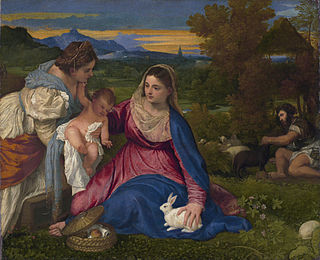
The Madonna of the Rabbit is an oil painting by Titian, dated to 1530 and now held in the Louvre in Paris. It is signed "Ticianus f." and is named after the white rabbit held in Mary's left hand. The rabbit is a symbol of fertility and – due to its whiteness – of Mary's purity and the mystery of the Incarnation, and is also a symbol of her virginity; female rabbits and hares can conceive a second litter of offspring while still pregnant with the first, resulting in them being able to give birth seemingly without having been impregnated.

The Gypsy Madonna is a panel painting of the Madonna and Child in oils of about 1510–11, by Titian, now in the Kunsthistorisches Museum in Vienna. It is a painting made for display in a home rather than a church.

The Pinacoteca del Castello Sforzesco is an art gallery in the museum complex of the Castello Sforzesco in Milan, northern Italy.

The Madonna of the Cherries is a 1515 painting by Titian, heavily influenced by the work of Giovanni Bellini. Originally oil on wood, it was later transferred to canvas. During the 17th century it formed part of the collection of Archduke Leopold Wilhelm, where it was copied by David Teniers. It is now in the Kunsthistorisches Museum in Vienna.
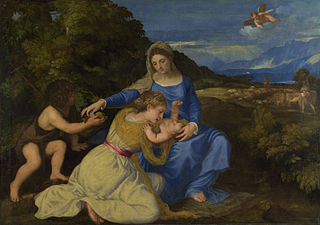
The Aldobrandini Madonna is an oil painting on canvas by Titian, dating to around 1530 and now in the National Gallery, London. There are studio copies in the Galleria Palatina in Florence and in the Kunsthistorisches Museum in Vienna.

The Madonna and Child with Two Musician Angels is an oil-on-panel painting by the Italian Renaissance painter Correggio, now in the Uffizi in Florence. Some date it to 1514–15 but it is more commonly dated to 1515–16.
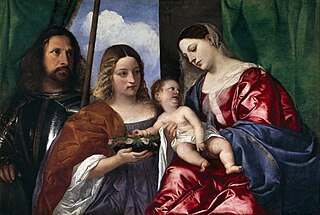
The Virgin and Child with Saints Dorothy and George is a c.1516 oil on panel painting by Titian, now in the Prado Museum in Madrid, to which it was transferred in 1839.



















